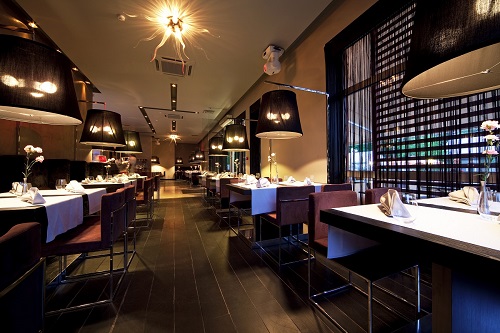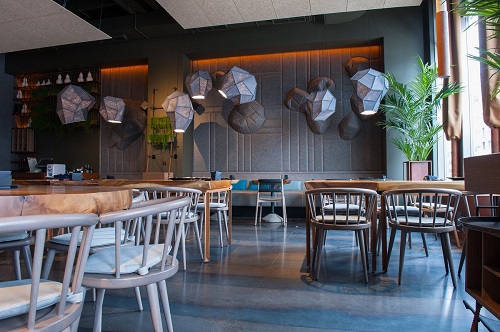When it comes to choosing the proper table for your restaurant, you will need to consider a few deciding factors.
- How much space do you have allotted for your front-of-house area?
- Who is your clientele?
- What is your budget?
- Are booths or individual tables more feasible?
Asking yourself the appropriate questions will help you narrow down the perfect table selection for your food service establishment.
All of your choices, from your menu items to how you set the table will affect your customers dining experience. Avoiding non-commercial tables will ensure that your restaurant is fit to withstand the heavy usage, and wear and tear that commercial furniture can handle. Make sure you know how much space you have to dedicate to your dining area. Choosing surfaces that are easy to clean will avoid the hassle of cleaning between crevices and grooved exteriors, especially with seating.

Tabletop Shape
Square Shape
Though the square option takes up more room than a round tabletop, a square tabletop is a contemporary choice that can add a bit of flare to your eatery. One downside is that a square table does not inspire intimate engagement between guests as a round design would due to the added distance between guests. However it is much easier to seat a larger party when you can combine square tables.
Round Shape
If your establishment serves a family oriented clientele, a round table may be a great option because of its lack of sharp edges, making it a safe choice for children. Round is also a great selection for encouraging closeness and conversation. But the disadvantage is that unlike its square counterpart, round tables can’t be expanded, and don’t accommodate large groups as easily.
Table Bases
When considering table bases, shape, height and finish will be major deciding factors. Bases come in many options and styles. Keep in mind that a mix –and-match setup may be the best solution for your establishment.
Base Height
Your table or base height will vary depending on the type of establishment and services. Do you have a bar area? Or will all of your tables be consistent in height? Common table base heights are as follows: Standard Height = 28” to 30" and Bar or Pub Height = 40" to 44". Standard Height Tables are most common and many guests find them to be more comfortable to sit at because they work well for children, older people and disabled patrons.

Round Base
The round bases are most widely used in restaurants. Paired with a round tabletop, this option is a very sturdy and reliable option.
Square Base
The square or rectangle table base is a popular option for larger tabletops that may require two bases to seat a larger party.
Tripod Base
The Tripod base has feet that create an X-shape. The benefit of this design is that it allows customers to fully push the chairs under the table, which creates more space. The downside of this is that X-shaped bases are not as sturdy as its round and square counterparts.
Floating Base
Floating bases are what you would see with a booth option. This choice allows you to set up booths along the wall, creating a more spacious seating area for your guests. You can add tables in order to accommodate a large party at your diner. They create an intimate setting, and are popular amongst many types of crowds. Based on information collected through city data, older guests may prefer the flexibility of open tables, as they like to stretch their legs out and move around more. Examining your market, can give you an idea of which choice will create the best dining experience for your clientele.

Material
Tabletop materials come in many different types. A few types of material include wood, butcher block, glass, quartz composite, granite, marble, and aluminum.
Wood Tabletop
Wood tabletops give your restaurant a warm, cozy feel and its appeal does not diminish with wear and tear, but instead adds character. However, wood is sensitive to excessive heat and moisture, and you will need to maintain it with a food grade mineral oil. The color is also likely to change over time.
Wood tabletops add a special character to the ambiance of a restaurant. The upside of having a wooden tabletop option is that it can be bruised or scuffed without subtracting from its overall appeal and beauty.
Marble Tabletop
Marble is timeless, and has a refined look. It is a pricier choice for those who are not overly concerned with being economical. Marble will require regular cleaning that includes using sealant applications, and sanding or honing due to etching.
Tip: If you want the elegance of marble but not the cost, try side boards or beverage stations with marble tops and linens for your regular dining tables. In a more formal setting, you could also serve dishes on sealed marble platters.Granite Tabletop
Perfect for a fine dining restaurant, granite is a modern option that is durable, easy to clean and attractive. Something to be mindful of when considering a granite tabletop option is that moisture and oils can stain the surface over time.
Quartz Tabletop
Slightly less expensive than granite, Quartz is another modern looking option. It comes in many different color choices including marble, white, beige, fawn, and others. It can, however, scratch or chip from excessive use and form discoloration from prolonged heat.
Aluminum Tabletop
Aluminum furniture offers durability, style and affordability all in one. You can use aluminum both indoors and outdoors without the worry of rusting and corrosion. Aluminum options are often coated with a powder finish that lasts for years without chipping or scratching.
Formica Tabletop
An inexpensive option, Formica is great for cutting costs, and it also comes in a variety of textures and colors. You can also paint formica to fit your restaurant’s unique style. You will want to prime your tabletop before painting to ensure your paint adheres to the slick surface. The downside to this product is that it is prone to scratches and burns.
Plastic Tabletop
Plastic is a popular option for tabletops, accounting for about 75 percent of the market. This option is durable, cost efficient, and it comes in a large array of colors. This is a great choice if you want to have many options, or present a varied selection of tabletops in your restaurant without the high costs.
Glass Tabletop
The aesthetic qualities of a glass tabletop are apparent. Glass provides a sophisticated, modernized option that will make an environment feel airy and light. On the contrary, and not surprising, glass can break easily and be difficult to clean. These downside characteristics make glass a less than ideal option for restaurants with heavy traffic, or a family-oriented clientele due to the safety risks associated.
May the Tables Turn in Your Favor
Your restaurant furniture choice will ultimately boil down to cost, or your planned budget. If saving is high on your priority list, there are ways you can cut costs. Choosing specific features over another (as mentioned previously) or shopping used restaurant tables are a good place to start.
Knowing the proper considerations for choosing your restaurant’s tables, puts you ahead of the pack. You can carefully decide what your needs are and how they can enhance the dining experience for your customers. Remember to make the most of your space, room shape, customer type, and budget, and you will be well on your way to having a perfectly fitted dining section.

